Lab Safety Manual - UCLA - Environment, Health & Safety
Lab Safety Manual - UCLA - Environment, Health & Safety
Lab Safety Manual - UCLA - Environment, Health & Safety
Create successful ePaper yourself
Turn your PDF publications into a flip-book with our unique Google optimized e-Paper software.
the proper respiratory equipment and training. Respirators will be selected and used in accordance<br />
with the requirements of CCR Title 8 Section 5144 (http://www.dir.ca.gov/Title8/5144.html) and the<br />
University‟s Respiratory Protection Program.<br />
In assessing exposure to hazardous chemicals for which Cal/OSHA has not published a PEL,<br />
STEL or Ceiling exposure, EH&S defers to the Threshold Limit Values (TLVs) established by<br />
the American Conference of Governmental Industrial Hygienists (ACGIH) or the Recommended<br />
Exposure Limits (RELs) established by the National Institute of Occupational <strong>Safety</strong> & <strong>Health</strong><br />
(NIOSH). Please contact the EH&S Hotline at 310-825-9797 for more information regarding<br />
these chemicals.<br />
NOTIFICATION<br />
The Industrial Hygiene Program will promptly notify the employee and his/her PI/<strong>Lab</strong>oratory<br />
Supervisor of the results in writing (within 15 working days or less if required) after the receipt of any<br />
monitoring results. The Industrial Hygiene Program will establish and maintain an accurate record of<br />
any measurements taken to monitor exposures for each employee. Records, including monitoring<br />
provided by qualified vendors, will be managed in accordance with CCR Title 8 Section 3204<br />
“Access to Employee Exposure and Medical Records” (http://www.dir.ca.gov/Title8/3204.html).<br />
EXPOSURE ASSESSMENT USE TO DETERMINE AND IMPLEMENT<br />
CONTROLS<br />
EH&S and OHF will use any of the following criteria to determine required control measures to<br />
reduce employee‟s occupational exposure:<br />
1. Verbal information obtained from employees regarding chemical usage;<br />
2. Visual observations of chemical use or laboratory operations;<br />
3. Evaluation of existing engineering control measures or administrative practices;<br />
4. Recommendations expressed in <strong>Safety</strong> Data Sheets;<br />
5. Regulatory requirements of Cal/OSHA;<br />
6. Recommendations from professional industrial hygiene organizations;<br />
7. Direct reading instrumentation results;<br />
8. Employee exposure monitoring results; and/or<br />
9. Medical evaluation, examination and/or surveillance findings.<br />
Particular attention shall be given to the selection of safety control measures for chemicals that are<br />
known to be extremely hazardous. Per Cal/OSHA CCR Title 8 Section 5141 “Control of Harmful<br />
Exposure to Employees” (http://www.dir.ca.gov/Title8/5141.html), the control of harmful exposures<br />
shall be prevented by implementation of control measures in the following order:<br />
1. Engineering controls, whenever feasible;<br />
2. Administrative controls whenever engineering controls are not feasible or do not achieve full<br />
compliance and administrative controls are practical; and<br />
3. Personal protective equipment, including respiratory protection, during:<br />
a. the time period necessary to install or implement feasible engineering controls<br />
b. when engineering and administrative controls fail to achieve full compliance<br />
c. in emergencies.<br />
Chemical Hygiene Plan 5-3 January 2013
















